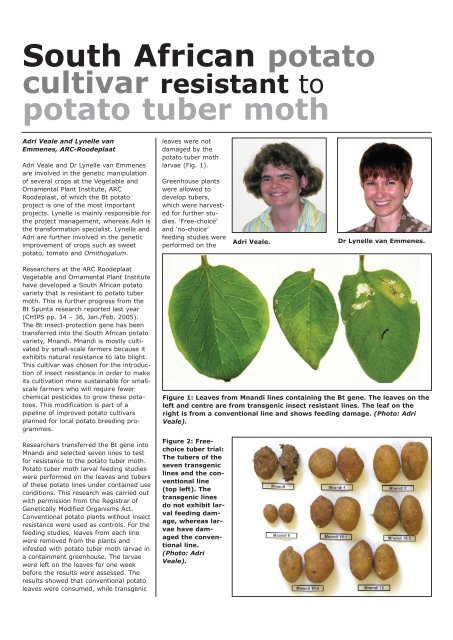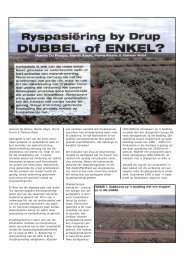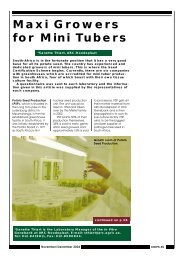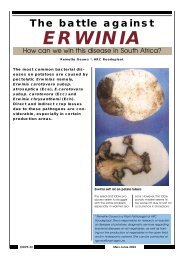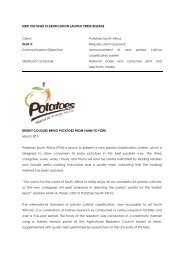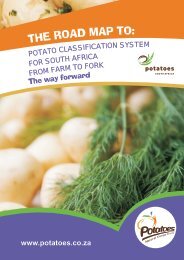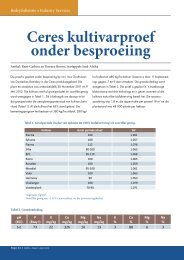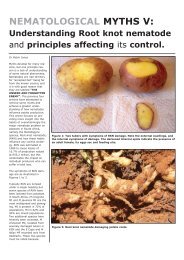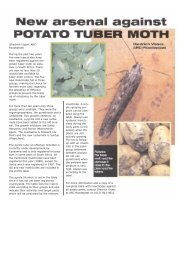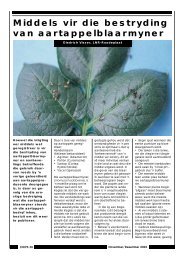ASA WEB Mrt/Apr 06 b - Potatoes South Africa
ASA WEB Mrt/Apr 06 b - Potatoes South Africa
ASA WEB Mrt/Apr 06 b - Potatoes South Africa
Create successful ePaper yourself
Turn your PDF publications into a flip-book with our unique Google optimized e-Paper software.
<strong>South</strong> <strong>Africa</strong>n potato<br />
cultivar resistant to<br />
potato tuber moth<br />
Adri Veale and Lynelle van<br />
Emmenes, ARC-Roodeplaat<br />
Adri Veale and Dr Lynelle van Emmenes<br />
are involved in the genetic manipulation<br />
of several crops at the Vegetable and<br />
Ornamental Plant Institute, ARC<br />
Roodeplaat, of which the Bt potato<br />
project is one of the most important<br />
projects. Lynelle is mainly responsible for<br />
the project management, whereas Adri is<br />
the transformation specialist. Lynelle and<br />
Adri are further involved in the genetic<br />
improvement of crops such as sweet<br />
potato, tomato and Ornithogalum.<br />
leaves were not<br />
damaged by the<br />
potato tuber moth<br />
larvae (Fig. 1).<br />
Greenhouse plants<br />
were allowed to<br />
develop tubers,<br />
which were harvested<br />
for further studies.<br />
‘Free-choice’<br />
and ‘no-choice’<br />
feeding studies were<br />
performed on the<br />
Adri Veale.<br />
Dr Lynelle van Emmenes.<br />
Researchers at the ARC Roodeplaat<br />
Vegetable and Ornamental Plant Institute<br />
have developed a <strong>South</strong> <strong>Africa</strong>n potato<br />
variety that is resistant to potato tuber<br />
moth. This is further progress from the<br />
Bt Spunta research reported last year<br />
(CHIPS pp. 34 – 36, Jan./Feb. 2005).<br />
The Bt insect-protection gene has been<br />
transferred into the <strong>South</strong> <strong>Africa</strong>n potato<br />
variety, Mnandi. Mnandi is mostly cultivated<br />
by small-scale farmers because it<br />
exhibits natural resistance to late blight.<br />
This cultivar was chosen for the introduction<br />
of insect resistance in order to make<br />
its cultivation more sustainable for smallscale<br />
farmers who will require fewer<br />
chemical pesticides to grow these potatoes.<br />
This modification is part of a<br />
pipeline of improved potato cultivars<br />
planned for local potato breeding programmes.<br />
Researchers transferred the Bt gene into<br />
Mnandi and selected seven lines to test<br />
for resistance to the potato tuber moth.<br />
Potato tuber moth larval feeding studies<br />
were performed on the leaves and tubers<br />
of these potato lines under contained use<br />
conditions. This research was carried out<br />
with permission from the Registrar of<br />
Genetically Modified Organisms Act.<br />
Conventional potato plants without insect<br />
resistance were used as controls. For the<br />
feeding studies, leaves from each line<br />
were removed from the plants and<br />
infested with potato tuber moth larvae in<br />
a containment greenhouse. The larvae<br />
were left on the leaves for one week<br />
before the results were assessed. The<br />
results showed that conventional potato<br />
leaves were consumed, while transgenic<br />
Figure 1: Leaves from Mnandi lines containing the Bt gene. The leaves on the<br />
left and centre are from transgenic insect resistant lines. The leaf on the<br />
right is from a conventional line and shows feeding damage. (Photo: Adri<br />
Veale).<br />
Figure 2: Freechoice<br />
tuber trial:<br />
The tubers of the<br />
seven transgenic<br />
lines and the conventional<br />
line<br />
(top left). The<br />
transgenic lines<br />
do not exhibit larval<br />
feeding damage,<br />
whereas larvae<br />
have damaged<br />
the conventional<br />
line.<br />
(Photo: Adri<br />
Veale).
tubers. For the free-choice study, four<br />
potato tubers of each line were placed in<br />
open containers inside an enclosed insect<br />
cage. Potato tuber moth pupae were<br />
placed in the middle of the insect cage.<br />
Once the moths eclosed from the pupae,<br />
they had a free choice to lay their eggs<br />
on any tuber inside the cage. For the nochoice<br />
study, four potato tuber moth larvae<br />
were placed on a tuber. In this<br />
study, the larvae were compelled to feed<br />
on the tubers they were place on. The<br />
results from both of these studies<br />
showed that the feeding larvae damaged<br />
the conventional tubers, whereas the<br />
transgenic tubers showed no evidence of<br />
larval feeding damage (Fig. 2 and 3).<br />
The conventional potatoes shriveled and<br />
exhibited tuber damage when cut open.<br />
1<br />
Figure 3: No-choice tuber<br />
trial: (1) The control, conventional<br />
potatoes after 1<br />
week exposure to potato<br />
tuber moth larvae show<br />
feeding damage. (2)<br />
Transgenic potatoes after<br />
1 week exposure to potato<br />
tuber moth larvae show<br />
no feeding damage.<br />
(Photo: Adri Veale).<br />
The next step in research assessment of<br />
these lines is to test the level of potato<br />
tuber moth resistance in field trials. If<br />
these lines perform well and are stable<br />
and uniform over several generations in<br />
several locations, one or two may be<br />
chosen for commercialization.<br />
2<br />
Data will be gathered on tuber moth leaf<br />
damage, damage to harvested and<br />
stored tubers, the general growth and<br />
performance of the transgenic Mnandi<br />
lines compared to conventional Mnandi.<br />
These lines will undergo extensive environmental,<br />
food and feed safety testing<br />
before being submitted to the Registrar<br />
of Genetically Modified Organisms Act<br />
for general use approval. The evaluation<br />
and safety testing process can take 4 to<br />
7 years.<br />
Vol 20 No 2 • March/<strong>Apr</strong>il 20<strong>06</strong>


